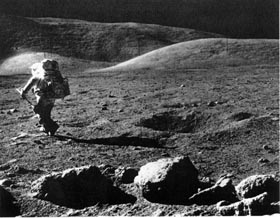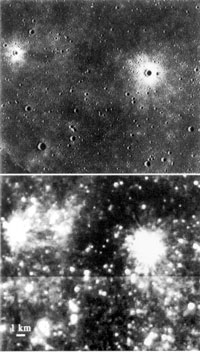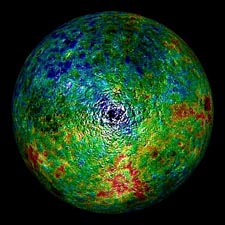|
The Moon offered an active battleground of contention.
The central argument for interpretation of the Apollo measurements with
seismometers placed on its surface by the astronauts is illustrated by [a
1985 "Fluffy" cartoon by W. B. Park in] Figure 19. [Not shown.
"Fluffy", the mascot of several critics of the small comets who
insist that the Moon should "ring like a bell"--even if the
objects are fluffy small comets--is shown falling through the air like a
rock. The caption notes that it doesn't matter whether Fluffy lands on
his feet or not.] That is, no matter what the impacting object on the
Moon was, rock or cat or small comet, the disturbances recorded by the
seismometers would be the same. Although amusing, this position is not
reasonable when one considers the different results of a hand-thrown rock
or snowball, each weighing one pound, for example. It was expected that
the Moon would be "ringing like a bell" from the large number
of meteors which were causing the fireballs in the Earth's atmosphere.
Surprisingly the Moon was silent, except for a relatively rare meteor
event or the thermal groans of the surface.
The ambiguity presented by the numerous fireballs in our atmosphere and
the "silence of the Moon" can be resolved with the existence of
small comets. The lunar surface is covered by a dust layer with
thicknesses typically in the range of feet. This soil layer is called
the regolith. The lunar seismometers could easily detect the impact of a
stony object because it penetrated through the soil layer to the bedrock
and "rang" the Moon's interior. On the other hand, the impact
of a fluffy small comet would produce shallow craters in the lunar soil,
 not sufficiently deep to penetrate to the bedrock. Because of this
shallow penetration and the structural fragility of the small comets only
weak disturbances would be caused by the small comet impacts. Indeed the
lunar surface is known to be saturated with shallow craters with
diameters of tens of feet which would be expected from numerous impacts
by small comets. A photograph of such a shallow crater is shown in Figure
20 [right] at the right-hand side of the Apollo astronaut.
not sufficiently deep to penetrate to the bedrock. Because of this
shallow penetration and the structural fragility of the small comets only
weak disturbances would be caused by the small comet impacts. Indeed the
lunar surface is known to be saturated with shallow craters with
diameters of tens of feet which would be expected from numerous impacts
by small comets. A photograph of such a shallow crater is shown in Figure
20 [right] at the right-hand side of the Apollo astronaut.
With the Polar spacecraft confirmations of the existence of small comets
in three independent ways there was a new flurry of activity intended to
show that their presence was contrary to the lunar cratering record.
This evidence was based upon the comparison of Apollo images of the lunar
surface in 1972 and images of the same area of the Moon with the
Clementine spacecraft in 1994. The comparison of these images separated
in time by 22 years in order to search for new impacts on the surface of
the Moon due to small comets was a great idea. Unfortunately the work
failed as to be noted by the images shown on the cover of Geophysical
 Research Letters of December 15, 1997 and reproduced here as Figure
21[left]. At the top of the figure is shown the high-resolution Apollo image. A
scale bar of 1 kilometer, or 3300 feet, in the bottom image is valid for
both images. The dimensions of the shallow craters from the impact of
the small comets are expected to be in the range of a few tens of feet at
most. The Apollo images are magnificent and do record craters of these
dimensions at their limits. The Clementine image of the same area of the
Moon is shown in the lower panel of Figure 21 [left]. The resolution of
this image is so poor that it takes some examination to convince the
viewer that the same surface area of the Moon is being examined. To
detect craters of the size associated with small comet impacts is
hopeless. To hypothesize huge bright spots as the cometary impacts defies
reasonable considerations of the actual impacts. It is disappointing that
the Clementine images were too blurry for the comparison. Otherwise the
results would have been very exciting.
Research Letters of December 15, 1997 and reproduced here as Figure
21[left]. At the top of the figure is shown the high-resolution Apollo image. A
scale bar of 1 kilometer, or 3300 feet, in the bottom image is valid for
both images. The dimensions of the shallow craters from the impact of
the small comets are expected to be in the range of a few tens of feet at
most. The Apollo images are magnificent and do record craters of these
dimensions at their limits. The Clementine image of the same area of the
Moon is shown in the lower panel of Figure 21 [left]. The resolution of
this image is so poor that it takes some examination to convince the
viewer that the same surface area of the Moon is being examined. To
detect craters of the size associated with small comet impacts is
hopeless. To hypothesize huge bright spots as the cometary impacts defies
reasonable considerations of the actual impacts. It is disappointing that
the Clementine images were too blurry for the comparison. Otherwise the
results would have been very exciting.
For many years after the original publication of the small comet papers
in 1986 a frequent objection to their presence in the vicinity of Earth
was based upon reports on the surface of the Moon during the Apollo
missions that there was a remarkable absence of water or water snow. The
critics claimed that the frequent impacts of the small comets on the
 lunar surface should have left tell-tale signs of water. Of course, even
though the Moon's gravity is relatively low in the sense that it cannot
prevent the high-speed water outflow from the small comet impacts from
escaping into space, there should be at least a little water ice or snow
which is trapped in the surface crevasses and other shadowed areas of the
lunar surface. The lunar surface is cold but any water ice or snow is
quickly vaporized by direct sunlight. Last year a remarkable search for
lunar water was reported by the Lunar Prospector spacecraft which is
currently orbiting the Moon. A sensor on board this spacecraft was
capable of remotely sensing the presence of hydrogen-bearing substances.
The most likely substance with hydrogen is water. One of the first maps
of this water on the lunar surface is shown in Figure 22 [right]. The
view is the northern polar region of the Moon. The color blue indicates
more water and red is lesser quantities. There are many tons of water in
the polar region. This fascinating survey continues with the spacecraft
orbit being adjusted to achieve lower altitudes and hence to obtain views
with better resolution. The Moon is not dry.
[Next Page]
lunar surface should have left tell-tale signs of water. Of course, even
though the Moon's gravity is relatively low in the sense that it cannot
prevent the high-speed water outflow from the small comet impacts from
escaping into space, there should be at least a little water ice or snow
which is trapped in the surface crevasses and other shadowed areas of the
lunar surface. The lunar surface is cold but any water ice or snow is
quickly vaporized by direct sunlight. Last year a remarkable search for
lunar water was reported by the Lunar Prospector spacecraft which is
currently orbiting the Moon. A sensor on board this spacecraft was
capable of remotely sensing the presence of hydrogen-bearing substances.
The most likely substance with hydrogen is water. One of the first maps
of this water on the lunar surface is shown in Figure 22 [right]. The
view is the northern polar region of the Moon. The color blue indicates
more water and red is lesser quantities. There are many tons of water in
the polar region. This fascinating survey continues with the spacecraft
orbit being adjusted to achieve lower altitudes and hence to obtain views
with better resolution. The Moon is not dry.
[Next Page]
|